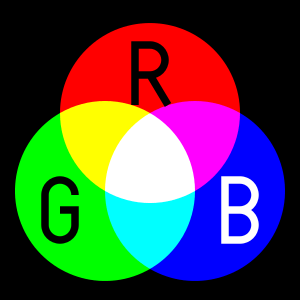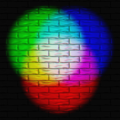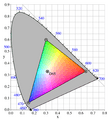RGB color model facts for kids
RGB (red, green, blue) is a way to create colors by mixing different amounts of red, green, and blue light. Think of it like shining three colored flashlights – one red, one green, and one blue – onto a white wall in a dark room.
Each flashlight has a dimmer switch to control how bright it is. If you only turn on the red light, the wall will look red. If you turn on only the green light, the wall will be green. But if you turn on both the red and green lights together, the wall will look yellow! If you dim the red light a bit, the yellow will become more of a yellow-green.
Every time you change the brightness of the three lights, you get a different color or a different brightness. All the colors you can make with these three lights are called the gamut. If you use a different red light that's a bit more orange, you'll get a slightly different set of colors you can make.
How RGB Works
The name RGB comes from the first letters of the three main colors: red, green, and blue. This color system is used in many digital devices like digital cameras, TVs, video cameras, and computers. It helps these devices capture, store, and show images.
The idea behind RGB colors is based on how human eyes see colors. Our eyes have tiny sensors that are mostly sensitive to red, green, and blue light.
The RGB color model is an additive color model. This means you add light together to make new colors.
- If you have no light (all colors are at zero brightness), you get black.
- If you add all three colors at their brightest, you get white.
This is different from mixing paints. When you mix different colored paints, you usually get a darker color, and mixing all colors of paint often makes black. That's called a subtractive color model.
A Little Bit of History
The idea of RGB colors comes from a theory about how we see colors, developed by scientists Thomas Young and Hermann von Helmholtz in the 1800s. Later, James Clerk Maxwell used this idea to create the first color photographs in 1861. He did this by taking three separate pictures, each through a red, green, or blue filter. Then, he projected these three pictures onto a screen in a dark room, and they combined to show a full-color image!
The modern RGB technology used in older TV screens (called CRT displays) was patented in Germany in 1938.
RGB Numbers
When computers and other devices use RGB, they represent each color as a set of numbers. This set is called an RGB triplet, like (r,g,b). Each number shows how much red, green, or blue is in the color.
- If all numbers are zero, you get black (no light).
- If all numbers are at their highest value, you get the brightest white.
These numbers can be shown in different ways:
- As a number from 0 to 1 (like 0.5 for half brightness).
- As a percentage from 0% to 100%.
- Most commonly in computers, as a number from 0 to 255. This is because computers often use 8-bit "bytes" for each color, and 255 is the largest number an 8-bit byte can hold. These numbers can be shown as regular numbers (decimal) or as hexadecimal numbers (like #FF0000).
- More advanced devices might use larger number ranges, like 0 to 1023 (10 bits) or 0 to 65535 (16 bits) for even more color detail.
For example, the brightest, purest red color can be written in different ways:
| Notation | RGB triplet |
|---|---|
| Arithmetic | (1.0, 0.0, 0.0) |
| Percentage | (100%, 0%, 0%) |
| Digital (8-bit per channel) | (255, 0, 0) or sometimes #FF0000 (hexadecimal) |
| Digital (12-bit per channel) | (4095, 0, 0) |
| Digital (16-bit per channel) | (65535, 0, 0) |
Images for kids
-
Additive color mixing: projecting primary color lights on a white surface shows secondary colors where two overlap; the combination of all three primaries in equal intensities makes white.
-
A set of primary colors, such as the sRGB primaries, define a color triangle; only colors within this triangle can be reproduced by mixing the primary colors. Colors outside the color triangle are therefore shown here as gray. The primaries and the D65 white point of sRGB are shown. The background figure is the CIE xy chromaticity diagram.
-
Cutaway rendering of a color CRT: 1. Electron guns 2. Electron beams 3. Focusing coils 4. Deflection coils 5. Anode connection 6. Mask for separating beams for red, green, and blue part of displayed image 7. Phosphor layer with red, green, and blue zones 8. Close-up of the phosphor-coated inner side of the screen
-
RGB phosphor dots in a CRT monitor
-
RGB sub-pixels in an LCD TV (on the right: an orange and a blue color; on the left: a close-up)
See also
 In Spanish: RGB para niños
In Spanish: RGB para niños







